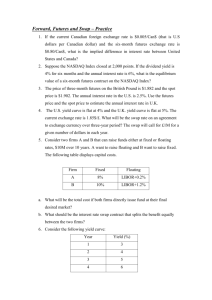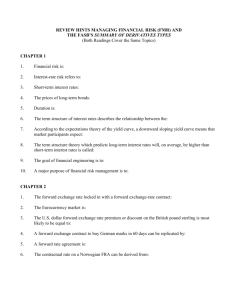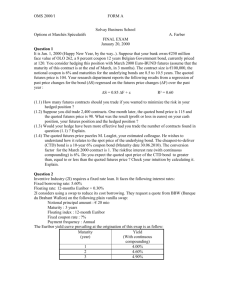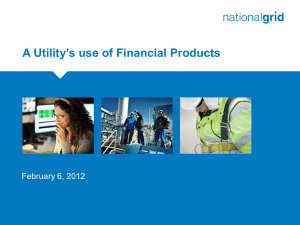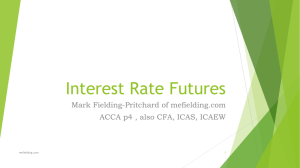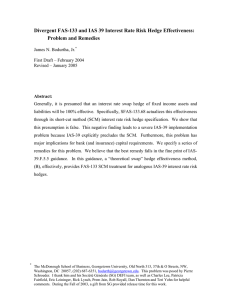Uncertainty about the future market value of an asset is referred to
advertisement
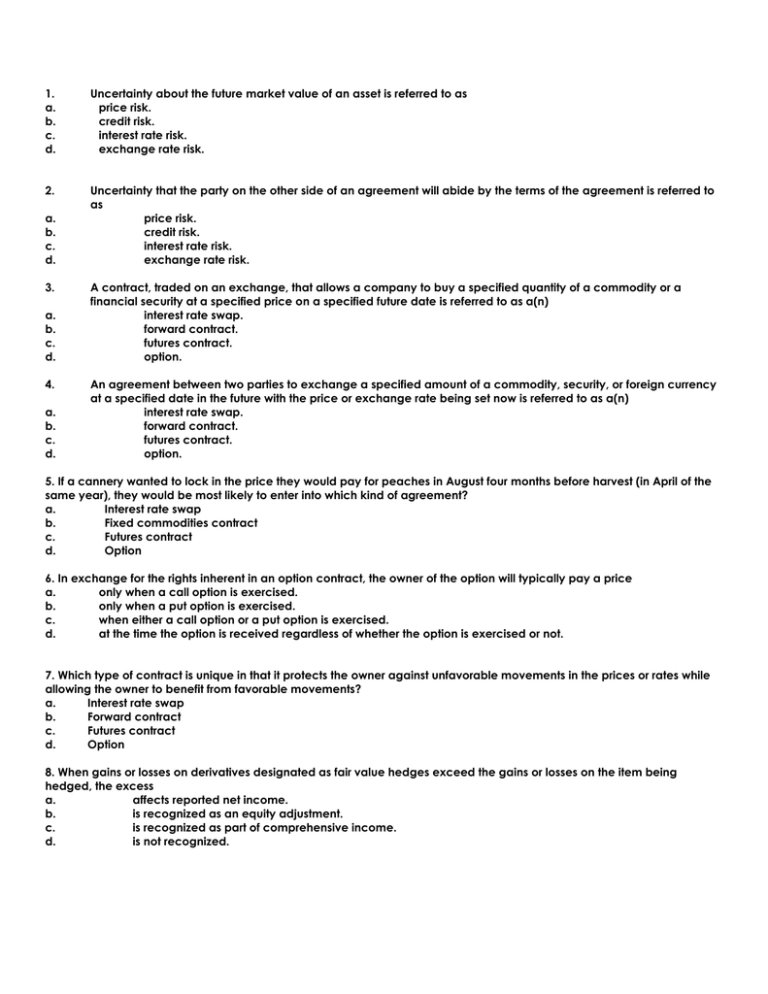
1. a. b. c. d. Uncertainty about the future market value of an asset is referred to as price risk. credit risk. interest rate risk. exchange rate risk. 2. Uncertainty that the party on the other side of an agreement will abide by the terms of the agreement is referred to as price risk. credit risk. interest rate risk. exchange rate risk. a. b. c. d. 3. a. b. c. d. 4. a. b. c. d. A contract, traded on an exchange, that allows a company to buy a specified quantity of a commodity or a financial security at a specified price on a specified future date is referred to as a(n) interest rate swap. forward contract. futures contract. option. An agreement between two parties to exchange a specified amount of a commodity, security, or foreign currency at a specified date in the future with the price or exchange rate being set now is referred to as a(n) interest rate swap. forward contract. futures contract. option. 5. If a cannery wanted to lock in the price they would pay for peaches in August four months before harvest (in April of the same year), they would be most likely to enter into which kind of agreement? a. Interest rate swap b. Fixed commodities contract c. Futures contract d. Option 6. In exchange for the rights inherent in an option contract, the owner of the option will typically pay a price a. only when a call option is exercised. b. only when a put option is exercised. c. when either a call option or a put option is exercised. d. at the time the option is received regardless of whether the option is exercised or not. 7. Which type of contract is unique in that it protects the owner against unfavorable movements in the prices or rates while allowing the owner to benefit from favorable movements? a. Interest rate swap b. Forward contract c. Futures contract d. Option 8. When gains or losses on derivatives designated as fair value hedges exceed the gains or losses on the item being hedged, the excess a. affects reported net income. b. is recognized as an equity adjustment. c. is recognized as part of comprehensive income. d. is not recognized. 9. For which type of derivative are changes in the fair value deferred and recognized as an equity adjustment? a. Fair value hedge b. Cash flow hedge c. Operating hedge d. Notional value hedge 10. On February 1, Shoemaker Corporation entered into a firm commitment to purchase specialized equipment from the Okazaki Trading Company for ¥80,000,000 on April 1. Shoemaker would like to reduce the exchange rate risk that could increase the cost of the equipment in pesos by April 1, but Shoemaker is not sure which direction the exchange rate may move. What type of contract would protect Shoemaker from an unfavorable movement in the exchange rate while allowing them to benefit from a favorable movement in the exchange rate? a. Interest rate swap b. Forward contract c. Call option d. Put option 11. A company enters into a futures contract with the intent of hedging an account payable of DM400,000 due on December 31. The contract requires that if the peso value of DM400,000 is greater than P200,000 on December 31, the company will be required to pay the difference. Alternatively, if the peso value is less than P200,000, the company will receive the difference. Which of the following statements is correct regarding this contract? a. The Deutsche mark futures contract effectively hedges against the effect of exchange rate changes on the peso value of the Deutsche mark payable. b. The futures contract is a contract to buy Deutsche marks at a fixed price. c. The futures contract is a contract to sell Deutsche marks at a fixed price. d. The contract obligates the company to pay if the value of the peso increases. 12. A company enters into an interest rate swap in order to hedge a P5,000,000 variable-rate loan. The loan is expected to be fully repaid this year on June 10. The contract requires that if the interest rate on April 30 of next year is greater than 11%, the company receives the difference on a principal amount of P5,000,000. Alternatively, if the interest rate is less than 11%, the company must pay the difference. Which of the following statements is correct regarding this contract? a. The swap agreement effectively hedges the variable interest payments. b. The timing of the swap payment matches the timing of the interest payments and, therefore, the variable interest payments are hedged. c. The timing of the swap payment does not match the timing of the interest payments and, therefore, the variable interest payments are not hedged. d. This swap represents a fair value hedge. 13. Alpha Company purchases a call option to hedge an investment in 20,000 shares of Beta Company stock. The option agreement provides that if the prices of a share of Beta Company stock is greater than P30 on October 25, Alpha receives the difference (multiplied by 20,000 shares). Alternatively, if the price of the stock is less than P30, the option is worthless and will be allowed to expire. Which of the following statements regarding this call option is correct? a. The call option effectively hedges the investment in the shares of Beta stock. b. The call option is an option to sell Beta Company stock at a fixed price. c. The call option represents a speculative option rather than a hedge. d. Alpha could have purchased a put option or a call option to effectively hedge the investment in the shares of Beta stock. 14. On July 1, 2002, Cahoon Company sold some limited edition art prints to Sitake Company for ¥47,850,000 to be paid on September 30 of that year. The current exchange rate on July 1, 2002, was ¥110=P1, so the total payment at the current exchange rate would be equal to P435,000. Cahoon entered into a forward contract with a large bank to guarantee the number of pesos to be received. According to the terms of the contract, if ¥47,850,000 is worth less than P435,000, the bank will pay Cahoon the difference in cash. Likewise, if ¥47,850,000 is worth more than P435,000, Cahoon must pay the bank the difference in cash. Assuming the exchange rate on September 30 is ¥105=P1, what amount will Cahoon pay to, or receive from, the bank (rounded to the nearest peso)? a. P18,913 payment b. P18,913 receipt c. P20,714 payment d. P20,714 receipt 15. On January 1, 2002, Cougar Company received a two-year P500,000 loan. The loan calls for payments to made at the end of each year based on the prevailing market rate at January 1 of each year. The interest rate at January 1, 2002, was 10 percent. Aggie company also has a two-year P500,000 loan, but Aggie's loan carries a fixed interest rate of 10 percent. Cougar Company does not want to bear the risk that interest rates may increase in year two of the loan. Aggie Company believes that rates may decrease and they would prefer to have variable debt. So the two companies enter into an interest rate swap agreement whereby Aggie agrees to make Cougar's interest payment in 2003 and Cougar likewise agrees to make Aggie's interest payment in 2003. The two companies agree to make settlement payments, for the difference only, on December 31, 2003. If the interest rate on January 1, 2003 is 8 percent, what will be Cougar's settlement payment to/from Aggie? a. P5,000 payment b. P5,000 receipt c. P10,000 payment d. P10,000 receipt
